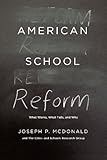American school reform : what works, what fails, and why / Joseph P. McDonald ; with Jolley Bruce Christman, Thomas B. Corcoran, Norm Fruchter, Milbrey W. McLaughlin, Gordon Pradl, Gabriel Reich, Mark Smylie, Joan Talbert.
Material type: TextLanguage: English Publisher: Chicago ; London : The University of Chicago Press, 2014Description: x, 199 pages : illustrations ; 23 cmContent type:
TextLanguage: English Publisher: Chicago ; London : The University of Chicago Press, 2014Description: x, 199 pages : illustrations ; 23 cmContent type: - text
- unmediated
- volume
- 9780226124728 (pbk. : alk. paper)
- 022612472X (pbk. : alk. paper)
- 370.973
- LA 217.2 M478a 2014
| Item type | Current library | Home library | Collection | Shelving location | Call number | Copy number | Status | Date due | Barcode |
|---|---|---|---|---|---|---|---|---|---|
 Libro
Libro
|
Biblioteca Juan Bosch | Biblioteca Juan Bosch | Humanidades | Humanidades (4to. Piso) | LA 217.2 M478a 2014 (Browse shelf(Opens below)) | 1 | Available | 00000163131 |
Includes bibliographical references (pages 163-186) and index.
The theory of action space -- Action space in Chicago and New York -- Action space in context: Philadelphia and the Bay area -- Learning from collapse in Philadelphia and Chicago -- Learning from connections in New York -- Implications for practice.
Dissecting twenty years of educational politics in our nation s largest cities, "American School Reform" offers one of the clearest assessments of school reform as it has played out in our recent history. Joseph P. McDonald and his colleagues evaluate the half-billion-dollar Annenberg Challengelaunched in 1994alongside other large-scale reform efforts that have taken place in New York, Chicago, Philadelphia, and the San Francisco Bay Area. They look deeply at what school reform really is, how it works, how it fails, and what differences it can make nonetheless. McDonald and his colleagues lay out several interrelated ideas in what they call a theory of action space. Frequently education policy gets so ambitious that implementing it becomes a near impossibility. Action space, however, is what takes shape when talented educators, leaders, and reformers guide the social capital of civic leaders and the financial capital of governments, foundations, corporations, and other backers toward true results. Exploring these extraordinary collaborations through their lifespans and their influences on future efforts, the authors provide political hopethat reform efforts can work, and that our schools can be made better.


There are no comments on this title.